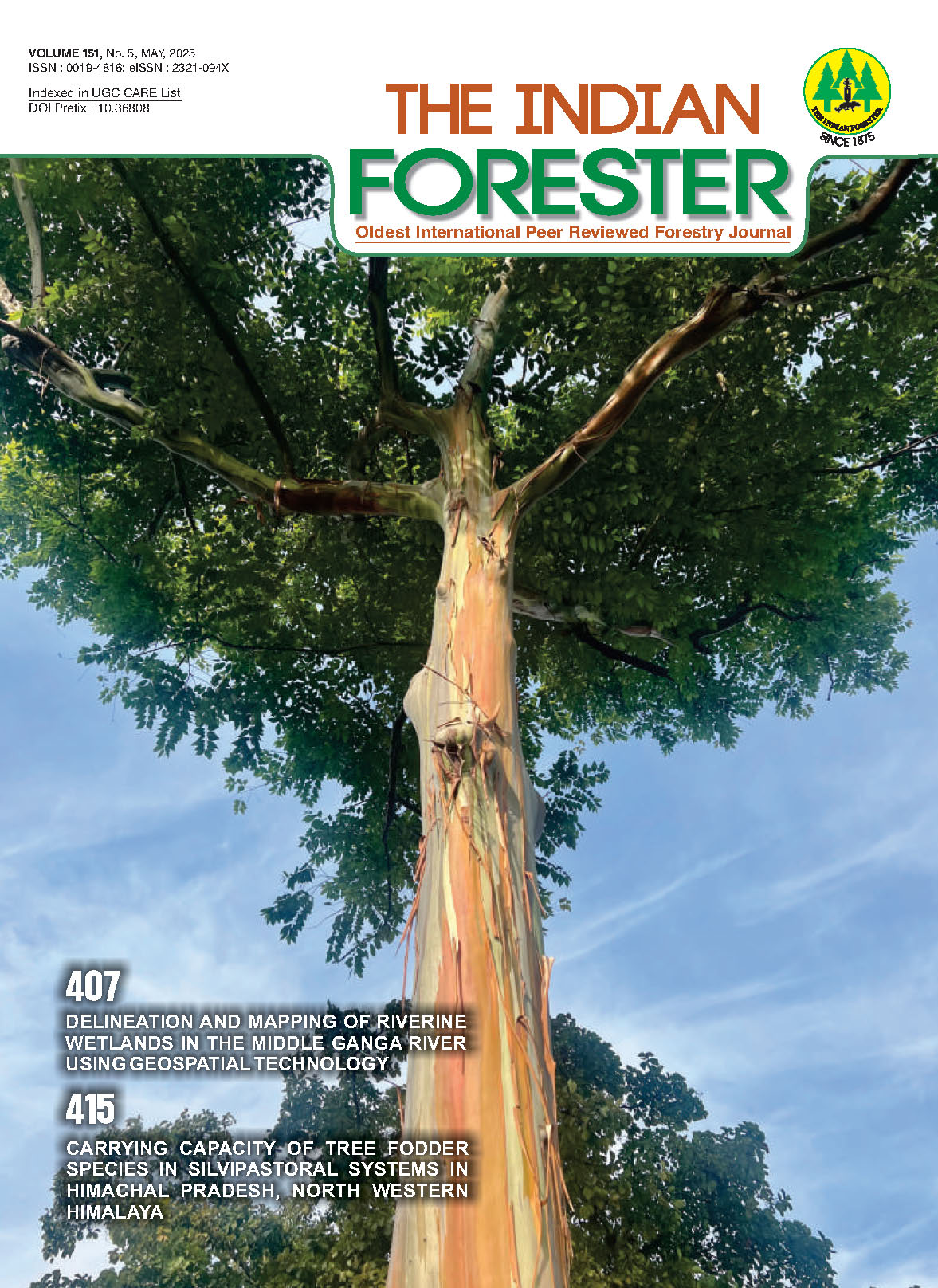Vegetative and Reproductive Phenology of some Selected Timber-yielding Tree Species in Borail Wildlife Sanctuary, Assam, India
DOI:
https://doi.org/10.36808/if/2025/v151i5/169670Keywords:
Arboreal species, Environmental impact, Northeast India, Phenophase, TreeAbstract
Phenological studies provide a better understanding in the periodicity of phenophases in various seasons and relationships between the species and environmental factors. This paper presents the phenology of 12-timber yielding tree species in relation to rainfall and temperature. A total of 36 matured individuals representing 12 tree species were monitored for phenology over a period of three years from 2017 to 2019 in Borail Wildlife Sanctuary, Assam, India. Phenological phases like period of leaf abscission, leaf initiation, leaf growth, flowering, fruiting, seed dispersal and germination were recorded fortnightly. Various environmental parameters like precipitation, temperature, seasonality, were found to play crucial roles on the phenology of the tree species. Relationship between various phenophases and environmental factors was examined by using Spearman's rank correlation coefficient. Leaf abscission manifested significant negative correlation with maximum and minimum temperature and rainfall, whereas, the remaining phenophases viz. leaf growth, flowering, fruiting and seed germination were shown significant positive correlation with temperature and rainfall for all the three years. The findings from this study can be utilized for management and conservation of the timber resources of the sanctuary in a scientific and sustainable way.
References
Anon., (2006). Management Plan of Borail Wildlife Sanctuary. Cachar and Karimganj Forest Division, Department of Environment and Forests, Government of Assam.
Bora P.J. and Kumar Y. (2003). Floristic diversity of Assam: Study of Pobitora Wildlife Sanctuary. Daya publishing house, Delhi.
Borchert R. (1994). Soil and stem water storage determine phenology and distribution of tropical dry forest trees. Ecology, 75: 1437-1449. DOI: https://doi.org/10.2307/1937467
Brandis D. (1906). Indian Trees: An Account of Trees, Shrubs, Woody Climbers, Bamboos and Palms Indigenous or Commonly Cultivated in the British Indian Empire. Archibald Constable & Co. Ltd, London. DOI: https://doi.org/10.5962/bhl.title.50463
Champion H.G. and Seth V. (1968). A revised survey of the forest types of India. Government of India Press, Delhi.
Chen X. and Xu L. (2012). Phenological responses of Ulmuspumila (Siberian Elm) to climate change in the temperate zone of China. International Journal of Biometeorol., 56: 695–706. DOI: https://doi.org/10.1007/s00484-011-0471-0
Davi H., Dufreˆne E., Francois C., Maire G.Le, Loustau D., Bosc A., Rambal S., Granier A. and Moors E. (2006). Sensitivity of water and carbon fluxes to climate changes from 1960 to 2100 in European forest ecosystems. Agr. Forest. Meteorol.,141: 35-56. DOI: https://doi.org/10.1016/j.agrformet.2006.09.003
Davi H., Gillmann M., Ibanez T., Cailleret M., Bontemps A., Fady B. and Lefevre F. (2011). Diversity of leaf unfolding dynamics among tree species: new insights from a study along an altitudinal gradient. Agr. Forest. Meteorol.,151: 1504-1513. DOI: https://doi.org/10.1016/j.agrformet.2011.06.008
Deb D.B. (1981-1983). The Flora of Tripura State, Vol. I & II. Today and Tomorrow's Printers and Publishers, New Delhi.
Doi H. and Katano I. (2008). Phenological timings of leaf budburst with climate change in Japan. Agricultural and Forest Meteorology, 148: 512–516. DOI: https://doi.org/10.1016/j.agrformet.2007.10.002
IPCC (2007). Climate change 2007: The Physical Science Basis. Contribution of working group I to the fourth assessment report of the intergovernmental panel on climate change, In: Solomon, S., D. Qin, M. Manning, Z. Chen, M. Marquis, K.B. Averyt, M. Tignor and H.L. Miller (eds.), United Kingdom and New York, NY, USA, Cambridge University Press, Cambridge, pp. 996.
Jain S.K. and Rao R.R. (1977). A Handbook of Field and Herbarium Methods. Today and Tomorrows Printers and Publishers, New Delhi.
Kanjilal U.N., Kanjilal P.C., Das A. and De R.N. (1934- 1940). Flora of Assam, Vols I-IV. Government of Assam, Shillong.
Karmer K. (1997). Phenology and growth of European trees in relation to climate change. In: Phenology of Seasonal Climates I. (H. Leith and M.D. Schwartz, Eds.), Bakhuys, The Netherlands, pp. 39-50.
Menzel A. Sparks T. Estrella N., Koch E., Aasa A., Ahas R., Alm Kubler K., Bissolli P., Braslavska O., Briede A., Chmielewski F.M., Crepinsek Z., Curnel Y., Dahl A., Defila C., Donnelly A., Filella Y., Jatczak K., Mage F., Mestre A., Nordli O,, Penuelas J., Pirinen P., Remisova V., Scheifinger H., Striz M., Susnik A., van Vliet A.J.H., Wielgolaski F.E., Zach S. and Zust A. (2006). European phonological response to climate change matches the warming pattern. Global Change Biology, 12(10): 1969-1976 DOI: https://doi.org/10.1111/j.1365-2486.2006.01193.x
Murali K.S. and Sukumar R. (1993). Leaf flushing phenology and herbivory in a tropical dry deciduous forest, southern India. Oecologia, 94: 114-119. DOI: https://doi.org/10.1007/BF00317311
Pullaiah T., Krishnamurthy K.V. and Bahadur B. (2016). Ethnobotany of India, Volume 1: Eastern Ghats and Adjacent Deccan. Apple Academic Press, New York. https://doi.org/10.1201/9781315366371 DOI: https://doi.org/10.1201/9781315366371
Van Schaik C.P., Terborgh J.W. and Wright S.J. (1993). The Phenology of tropical forests: Adaptive significance and consequences for primary consumers. Annual Review of Ecology and Systematics, 24: 353-377. DOI: https://doi.org/10.1146/annurev.es.24.110193.002033
Wright S.J. and Van Schaik C.P. (1994). Light and the phenology of tropical trees. Am. Nat., 143: 192-199. DOI: https://doi.org/10.1086/285600
Zhang G., Song Q. and Yang D. (2006). Phenology of Ficus racemosa in Xishuangbanna, Southwest China. Biotropica, 38: 334-341. DOI: https://doi.org/10.1111/j.1744-7429.2006.00150.x
Downloads
Downloads
Published
How to Cite
Issue
Section
License
Unless otherwise stated, copyright or similar rights in all materials presented on the site, including graphical images, are owned by Indian Forester.





